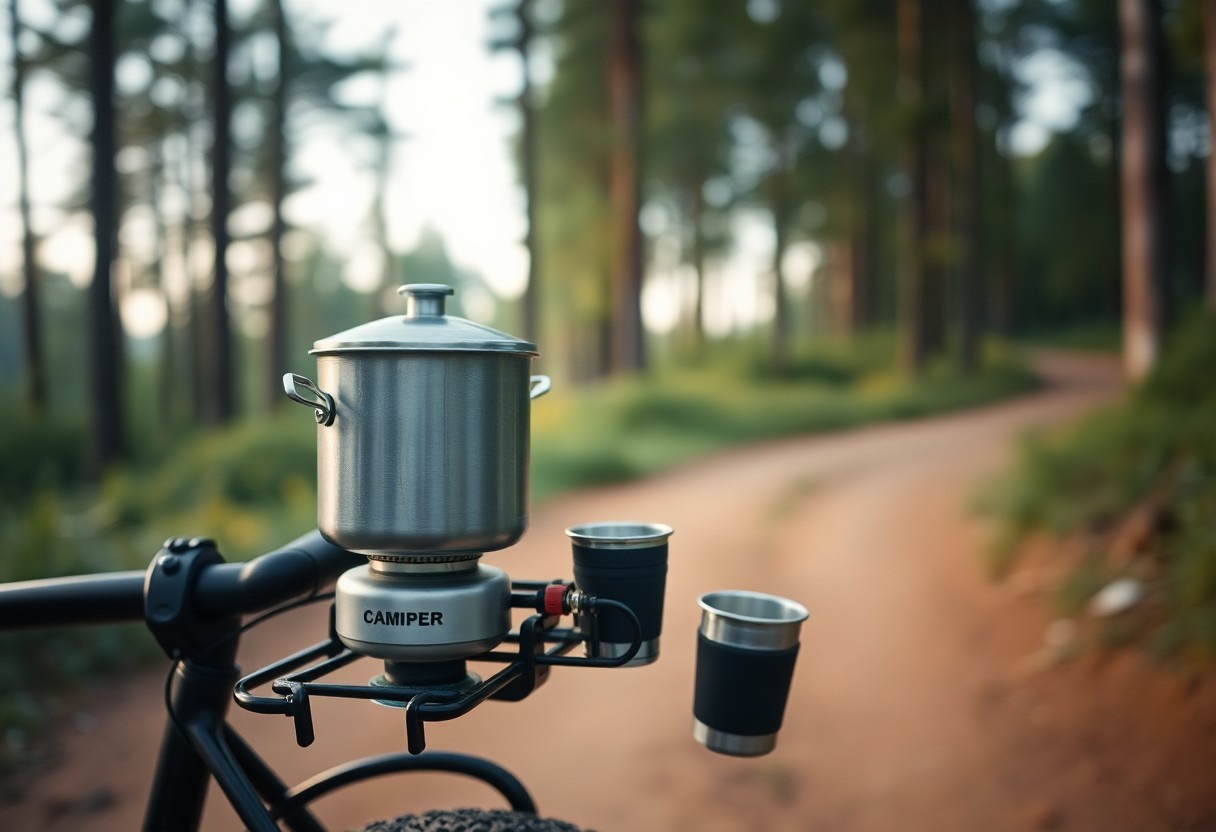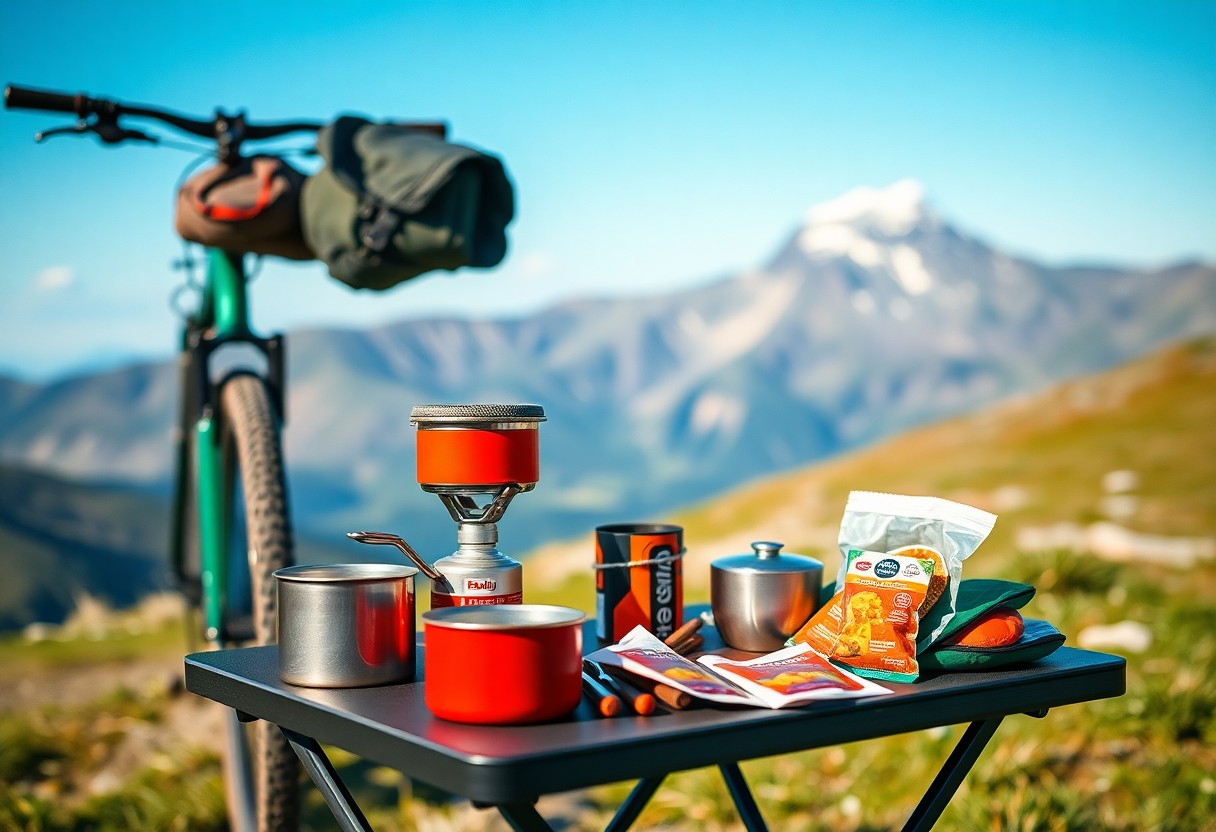With the right cooking solutions, you can elevate your bikepacking experience and enjoy delicious meals on your adventures. As you venture into the great outdoors, it’s important to consider lightweight, compact options that won’t weigh you down. From portable stoves to effective meal prep techniques, this guide will provide you with the best choices for cooking while on the move, ensuring that your energy stays up and your meals remain satisfying throughout your journey.
Key Takeaways:
- Portable cooking equipment such as compact stoves and lightweight cookware are important for efficient meal preparation while bikepacking.
- Prepared meals and dehydrated food options offer convenience and reduce cooking time, making them ideal for on-the-go nourishment.
- Utilising multi-functional tools can save space and weight, enhancing your packing efficiency without sacrificing cooking capabilities.
Essential Gear for Efficient Camp Cooking
The success of your bikepacking culinary experience hinges on the right gear. A well-planned setup ensures that you not only savour delicious meals but also manage your time and energy effectively. Focus on a compact stove, reliable fuel source, and versatile cookware to create an efficient cooking system. Opt for items that enhance portability without compromising on functionality; this way, you’ll not only enjoy your meals but also relish the thrill of cooking outdoors.
Lightweight Cookware: Balancing Weight and Durability
Investing in lightweight cookware is pivotal for bikepacking, as it decreases the burden on your ride. Look for pots and pans made from materials like titanium or anodised aluminium, which offer excellent heat conduction while keeping weight to a minimum. Brands such as MSR and Sea to Summit deliver high-quality options that withstand rugged use, ensuring you can rely on them throughout your journey.
Multi-functional Tools: The Swiss Army Knife of Cooking
Multi-functional tools enhance your cooking capabilities while saving precious packing space. These ingenious gadgets combine several functions into one compact item, allowing you to chop, open cans, and even serve meals with ease. A good example is a spoon-fork combination or a compact camping knife with built-in features, which can be invaluable when preparing dishes on the go.
A multi-functional tool typically offers a variety of necessities in a single, easy-to-carry design. Many models incorporate a knife, fork, spoon, bottle opener, and even a small cutting board, making meal preparation seamless. You’ll find that brands like Leatherman and Gerber provide reliable options that withstand the rigors of outdoor cooking, allowing you to tackle whatever culinary adventure lies ahead without carrying multiple items. Simplifying your tools not only lightens your load but also enhances the overall efficiency and enjoyment of your bikepacking experience.
Portable Fuel Options: Choosing the Right Energy Source
Selecting the right fuel source is vital for your bikepacking adventure. Each fuel option offers distinct features, tailored to various cooking styles and weight considerations. Options typically include liquid fuels, canister gas, and alternative eco-friendly fuels. Assess your cooking requirements and travel distance, ensuring you pack a solution that aligns with both your culinary ambitions and your commitment to pack light.
Liquid Fuels vs. Canisters: Making the Right Choice
Liquid fuels, such as white gas or kerosene, provide flexibility and are easy to refill, making them ideal for longer trips or extreme conditions. Canisters, on the other hand, are lightweight and convenient, with integrated valves for efficient usage. Choose liquid fuels for extended outings or colder climates, while single-day excursions can favour the simplicity of canisters, ensuring your meals stay swift and hassle-free.
Alternative Fuels: Embracing the Eco-Friendly
Alternative fuel options, such as biofuels or solid fuel tablets, cater to environmentally conscious travellers. These fuels produce minimal emissions and are often derived from renewable resources. Incorporating alternatives reduces your ecological footprint while still meeting your cooking needs on the go.
Biofuels, derived from organic materials, can be an appealing choice for those aiming to lighten their environmental impact. For instance, even improvised options like using wood or biomass can fuel a fire when you’re camping in a natural setting, all while avoiding the need for manufactured canisters or heavy liquid fuels. Additionally, solid fuel tablets, while compact, burn cleanly, ensuring minimal waste during your bikepacking journey. Exploring these eco-friendly alternatives reflects not only your passion for adventure but also a commitment to sustainable practices, allowing you to enjoy nature without compromising it.
Meal Preparation Strategies for On-the-Go Chefs
Your bikepacking expedition shouldn’t mean sacrificing quality meals. With a few strategic approaches to meal preparation, you can enjoy nutritious and satisfying dishes wherever your adventures take you. Preparing meals in advance, considering your cooking equipment, and choosing the right ingredients will contribute to a seamless cooking experience while on the move.
Pre-Packaged Meals: Convenience Without Compromise
Pre-packaged meals offer an enticing solution for on-the-go bikepackers who desire convenience without compromising quality. These ready-to-eat options can provide you with necessary nutrients and energy, often packed with flavours that can rival traditional cooking. Many companies now focus on creating meals with natural, minimally processed ingredients, ensuring that you maintain your dietary preferences while saving time and effort.
Fresh Ingredients: The Importance of Versatility and Preservation
Incorporating fresh ingredients into your bikepacking meals can elevate your culinary experience, making it easier to create varied dishes. Their versatility means you can mix and match flavours, whilst proper planning and preservation methods can keep them fresh longer, adding value to your outdoor cooking.
Fruits and vegetables, for example, can last several days without refrigeration, especially when stored in breathable bags. Opting for hardy produce, such as carrots or cherry tomatoes, increases your chances of enjoying fresh ingredients throughout your journey. Pairing these with stored grains or proteins creates balanced meals that can be as simple or elaborate as you desire, enabling you to cater to your tastes and nutritional needs while on the trail.

Techniques for Cooking in Varied Conditions
Adapting your cooking techniques to different environmental conditions is important for enjoying your meals while bikepacking. From fierce winds to torrential rain, you can still whip up nutritious dishes with a bit of foresight. Bringing a windscreen for your stove can enhance efficiency, while choosing lightweight, compact cookware helps manage space and weight. Knowing how to use different cooking methods, like no-cook options or one-pot meals, will also enable you to focus on enjoying the outdoors rather than wrestling with your cooking setup.
Adapting to Weather: Cooking in the Rain or Wind
Cooking in wet or windy conditions poses unique challenges, but you can still enjoy warm meals. Secure your stove with a stable base and use a windscreen to protect the flame. In the rain, consider setting up a tarp or using a covered space for shelter while cooking. Opt for quick-cooking meals, such as instant noodles or dehydrated meals that require minimal prep. Keeping your cooking gear dry and prioritising lightweight options will make your experience more pleasant.
Cooking at Altitude: Nutrition and Performance Considerations
Cooking at higher altitudes affects not only the way your food cooks but also your nutritional needs. As you ascend, boiling points decrease, making it challenging to cook food thoroughly. Adjust your meals to include high-energy snacks and quick-cooking options that provide important nutrients, like protein and carbohydrates, to fuel your journey. Staying hydrated is equally critical, as altitude can exacerbate dehydration.
When cooking at altitude, consider utilising freeze-dried meals which often rehydrate quickly, allowing you to maximise your cooking efficiency. The reduction of oxygen can make physical exertion more strenuous, so meals should be rich in complex carbohydrates to sustain energy over long rides. Additionally, making sure your ingredients are calorie-dense will compensate for the increased energy demand at higher elevations. Always acclimatise properly and monitor your body’s response to the altitude while keeping nutrition in mind for an enjoyable bikepacking experience.
Maximising Nutritional Value on the Trail
Focusing on nutritional value while bikepacking ensures you maintain stamina and energy throughout your journey. Pack a variety of nutrient-dense foods that not only fuel your rides but also support recovery. Incorporate whole grains, lean proteins, healthy fats, and fresh fruits where possible. Keeping an eye on portion sizes and meal timing allows for optimal digestion and energy levels during your adventures.
Carbohydrates, Proteins, and Fats: The Triad of Energy
Carbohydrates are your primary energy source, especially for endurance activities like biking; they maintain your energy levels. Proteins are vital for muscle repair and recovery after long days in the saddle, while healthy fats provide sustained energy for those extensive rides. Balancing these macronutrients ensures you have the necessary fuel, promotes optimal performance, and supports overall health during your bikepacking trip.
Hydration Strategies: Keeping Fluid Intake Optimal
Staying hydrated is imperative, as dehydration can impair performance and recovery. Carry a sufficient supply of water or use a hydration system on your bike for easy access. Aim for around 2-3 litres a day, adjusting for heat and physical exertion, and consider electrolyte supplements if you are sweating heavily or biking in hot conditions.
Monitor your hydration status by observing factors like the colour of your urine, which should ideally be pale yellow. During rigorous outings, incorporate hydration packs or lightweight bottles to ensure easy access to water as you ride. Remember to hydrate before, during, and after your rides, and consume electrolyte drinks if your journey spans long distances or hot weather. Adding foods with high water content, such as fruits, can also assist in maintaining optimal hydration.
Final Words
The top cooking solutions for bikepacking on the go include lightweight camping stoves, compact cookware sets, and easily packable utensils that maximise your efficiency without adding excess weight. Opt for versatile meal options like dehydrated meals or ready-to-eat pouches, which are convenient for your on-the-road cooking needs. Additionally, don’t overlook portable fuel sources, such as canisters or solid fuel tablets, to ensure you can cook meals wherever your adventure takes you. By choosing the right combination of gear, you enhance your bikepacking experience with delicious and nourishing meals.
FAQ
Q: What are the best cooking equipment options for bikepacking?
A: The best cooking equipment options for bikepacking typically include lightweight stoves, compact cookware, and multi-functional utensils. A popular choice is a canister stove, which is easy to set up and provides consistent heat. Consider a small pot or pan made from titanium or aluminium, as these materials are both lightweight and durable. Additionally, a spoon-fork combination utensil can save space and minimise weight, allowing you to pack efficiently while still having the tools you need for preparing and enjoying meals on the go.
Q: How can I effectively prepare meals while on a bikepacking trip?
A: Preparing meals during a bikepacking trip can be simplified by choosing light, non-perishable food items that require minimal cooking, such as instant rice, pasta, or dehydrated meals. To reduce cooking time and effort, consider pre-prepping ingredients at home, such as marinating proteins or cutting vegetables. Additionally, using a one-pot cooking method can make it easier to prepare meals and reduce cleanup time. Bringing along pre-measured spices and condiments in small containers can also enhance the flavour of your meals without adding significant weight.
Q: Are there any recommended food items for bikepacking?
A: Recommended food items for bikepacking should be lightweight, high in energy, and easy to prepare. Options such as energy bars, nuts, dried fruits, and jerky make for excellent snacks that provide sustenance throughout the day. For main meals, consider dehydrated or freeze-dried meals, as they only require boiling water to prepare and have a long shelf life. Additionally, foods like instant oatmeal, couscous, and quinoa are nutritious choices that are quick to prepare. Always consider your dietary preferences and nutritional needs to ensure you remain energised and satisfied during your adventures.
